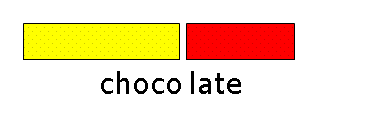Olha Madylus tells us what Cuisenaire rods are and why they are useful for teaching English to young learners.
 |
What are Cuisenaire rods?
They are small blocks of wood of different lengths. Each different length is a different colour. They were originally used for teaching Maths. You can use them to denote different types of words in sentences, show word and sentence stress and to symbolize elements of a story.
Once upon a time in Bolivia
I was teaching a class of young learners aged between nine and eleven in Quito, Bolivia. We had been learning all about the vocabulary for houses and homes and I got out my boxes of Cuisenaire rods in order to practise the words. We all got down on the floor and in groups the children took a box of rods and started ‘building’ their own houses, telling each other about what they were building. I could hear them use the target vocabulary: bedroom, kitchen, garden, roof, walls etc., as well as lots of other words they knew, such as a wide array of adjectives to describe colours, sizes, qualities. They were adding super phrases such as, "I have sharks in the swimming pool". They were engrossed in the activity and time passed without any of us noticing. When I realized that the class should have finished some time earlier and asked the children to tidy up, there were protests and sighs as they wanted to continue*. That’s when I realized that Cuisenaire rods are not just practical, neat aids to language teaching but that they also possess magical properties.
(* This was a pure Csikszentmihalyi moment of Flow. He says that "Human beings feel best in flow, when they are fully involved in meeting a challenge, solving a problem, discovering something new..." and this is when we stop noticing time passing and are oblivious to distractions.)
Why use Cuisenaire rods?
They are practical and neat:
They are small, easy to store, easy to handle and can be used in very many ways to support language learning and teaching. They are different lengths and colours and thus easy to differentiate. They are also unbreakable (as far as know and my young learners have certainly used them roughly at times).
They are not just useful for classroom teaching, but are also particularly effective in teaching one-to-one classes or small groups.
They are magical:
They are brightly coloured and appeal to our visual intelligence (see Howard Gardner’s Multiple Intelligence Theory). There is something very satisfying about handling smooth pieces of wood (and not just for children. I was devastated when the glorious wooden Cuisenaire rods were replaced with plastic ones). This appeals to our haptic sense:
From: Merriam-Webster's Medical Dictionary
Main Entry: hap•tic
Pronunciation: 'hap-tik
Function: adjective
1: relating to or based on the sense of touch, "the haptic mode of perception"
2: characterized by a predilection for the sense of touch "a haptic person"
Children like touching, picking things up, moving them. That is why many toys for young children are designed to have different textures on the surfaces to stimulate their interest and pleasure. It is truly amazing how small pieces of wood can be used to symbolize not just words, but also ideas and elements of a story, even people. It reveals a lot about the power of the imagination. Below are some example activities for using Cuisenaire rods in class (but just using a little bit of imagination, I am sure teachers and students alike can find many uses for them):
Some activities for using rods with young learners
1. Comparisons – if we need to make concrete the concepts of big/small and bigger/smaller, we can of course use pictures or talk of things in common experience, e.g. an elephant is bigger than a mouse, but the rods are a clear and tangible way of getting across the concepts with young learners. They can be used to present the language and also children can play with the rods and express meaning. They can actually compare the rods and talk about their discoveries. In this way it’s easy for the teacher to check that they understand the language.
2. Word order – you stick labels on the markers or write the parts of speech on each rod with a marker: Subject, Verb, Object, Adjective, Adverb, Preposition, Pronoun etc. I would do this with older learners (10+) who are familiar with the terminology and have enough English to find the activity valuable.
The students can brainstorm onto large sheets of paper words which fall into these categories, choose some to use and practise mixing them around before deciding whether the sentences work.
Table: Word order Cuisenaire rods
For example, Superman quickly found the tired boys in the cave is okay, but Tigers dangerous eat quickly boys is not. This is a great way to focus on those difficult adverbs, which can move around a sentence.
3. Word stress within a sentence – Young (and older) students sometimes find it difficult to hear the difference between stressed and unstressed syllables. If you write the words down on a big piece of paper, and use one colour rod for unstressed and another colour for stressed syllables, the students can then 'see' as well as hear where the stress is. With some helpful blu-tac on the rods you can also do this on the board.
Example: photograph
 |
Example: chocolate
There are words that defy many non-native speakers of English, e.g. chocolate, where they insist on making it a three syllable word or even four. Using rods to ‘show’ the number of syllables is very helpful and memorable.
 |
4. Prepositions – Rods are great for presenting and practising prepositions. Teacher can demonstrate this activity and then students work in pairs to practise. Arrange students so they are sitting opposite each other with a desk in between. They need to create a barrier between them, a coursebook, for example. Give the same number and colours of rods to each student. Taking it in turns one student arranges her rods behind the barrier, then describes the structure to her partner (e.g. the red rod is lying on top of the blue rod; the yellow rod is standing opposite the white rod), who has to try to arrange her rods in the same way. When they have finished, they remove the barrier and check if they have managed to end up with similar structures. I find students will happily to this activity many times (you can change partners for variety) and thus get lots of practise of target language, plus they often try to use other language they know to facilitate the task.
Some activities for using rods with very young learners
a. To practise counting, using number words and combining English and Maths (CLiL) counting, adding, and taking away.
b. Which hand is it in? One student takes a rod and puts both hands behind her back. She then brings both hands forward and says, "Which hand is it in?" Her partner has to guess and say "right" or "left". This is good to learn the initial chunk and to practise left/right, while playing a little game. Children could do this a number of times, keeping a record of right/wrong guesses and then create two piles of rods to indicate their success rate.
c. Which colour do I have in my hand? This is similar to the above, but guessing colours. Children will get extensive, student-centred practice of the vocabulary.
d. Build a train – ask students to build a train of different carriages using rods, then describe their train. Depending on language proficiency, students could simply use the colours, e.g. "The train is blue and red and brown". Or perhaps use words like carriage with long, short etc.
e. Dictations. The teacher divides out the rods to the students and describes something. The students must use their rods to create an image of what they hear. E.g. The monster has a blue head and red legs / The boy stood by the blue river. He was wearing a white hat. His brown dog was near him.
Stories
As we see rods can take on symbolic value and so can be used in story-telling. Firstly, as a teacher tells a story she can use rods to indicate key elements in the story. For example:
The teacher can finish the story alone or with the help of the students. After telling the story, invite students to retell the story using rods or to tell their own. Don’t worry too much about accuracy in this activity, but encourage students to practise their story-telling skills and enjoy the magic.







No comments yet